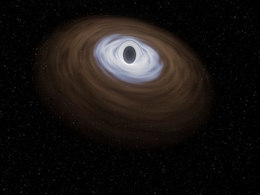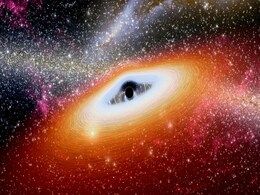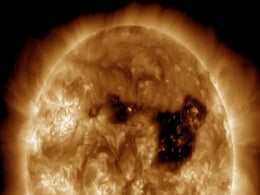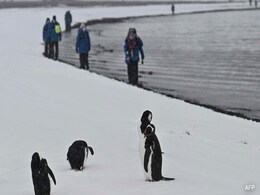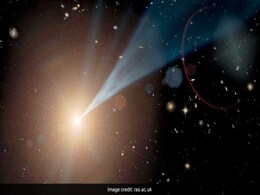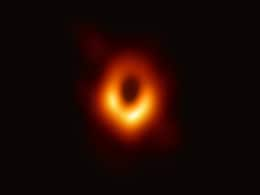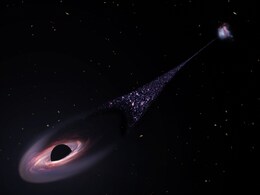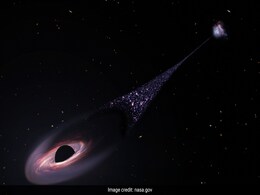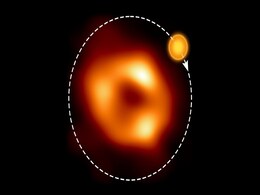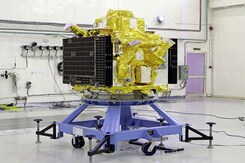Holes In The Sun
- All
- News
- Videos
-

NASA Hubble Space Telescope Helps Confirm the First Solitary Black Hole
- Friday April 18, 2025
- Written by Gadgets 360 Staff
In the Sagittarius constellation, a lone and first-ever solitary black hole has been discovered by a team of scientists. Although the discovery began in the year 2011, the observations have confirmed it recently. The size of this black hole is as massive as seven times of the sun. Despite the conflicts and differences of observations by another tea...
-
 www.gadgets360.com
www.gadgets360.com
-

Supermassive Black Hole May Be Hiding in Large Magellanic Cloud, Scientists Suggest
- Monday March 10, 2025
- Written by Gadgets 360 Staff
A potential supermassive black hole may exist in the Large Magellanic Cloud, as per recent scientific findings. Researchers analysed hypervelocity stars moving at extreme speeds and found many could have been ejected from this neighbouring galaxy. The black hole is estimated to be around 600,000 times the mass of the Sun. If confirmed, this discove...
-
 www.gadgets360.com
www.gadgets360.com
-

Astronomers Find a 200,000-Light-Year Black Hole Jet in the Early Universe
- Monday February 10, 2025
- Written by Gadgets 360 Staff
Astronomers have identified the longest black hole jet observed in the early universe, stretching 200,000 light-years—twice the Milky Way’s width. Found in quasar J1601+3102, this jet was detected using the LOFAR telescope. Despite the black hole being 450 million times the Sun’s mass, it isn’t among the most massive. Scientists believe env...
-
 www.gadgets360.com
www.gadgets360.com
-

Massive Coronal Hole on Sun Sends High-Speed Solar Wind Toward Earth
- Tuesday February 4, 2025
- Written by Gadgets 360 Staff
A giant 800,000 km coronal hole on the Sun is unleashing high-speed solar wind toward Earth, potentially triggering a G1 geomagnetic storm on January 31 and February 1. The NOAA has issued a watch, predicting enhanced auroras in higher latitudes. While G1 storms are minor, they can impact satellites and power grids. The storm’s intensity remains ...
-
 www.gadgets360.com
www.gadgets360.com
-

Massive 500,000-Mile Coronal Hole on the Sun Blasts Solar Wind Toward Earth
- Thursday January 30, 2025
- Written by Gadgets 360 Staff
A gigantic coronal hole, spanning 500,000 miles, has formed on the sun’s surface, allowing solar wind to escape at speeds of over 310 miles per second. Forecasts indicate that this solar wind may reach Earth by January 31, triggering a minor (G1) geomagnetic storm. While no severe impact is expected, the storm could enhance auroras at higher lati...
-
 www.gadgets360.com
www.gadgets360.com
-

Solar Wind from Sun's Large Coronal Hole Could Create Auroras This Weekend
- Saturday January 4, 2025
- Written by Gadgets 360 Staff
A powerful solar wind is expected to hit Earth this weekend, originating from a massive coronal hole in the sun’s atmosphere. This phenomenon could result in dazzling northern lights, particularly in high-latitude regions. NOAA has issued a G1 geomagnetic storm warning for January 4-5, forecasting heightened geomagnetic activity.
-
 www.gadgets360.com
www.gadgets360.com
-

Solar 'Battle Zone' Could be Even Worse Than Solar Maximum, Experts Warn
- Friday December 6, 2024
- Written by Gadgets 360 Staff
Experts warn that the sun's next phase, the "battle zone," could result in increased geomagnetic activity, lasting until 2028. This period could bring heightened solar flares and coronal holes, which may cause disruptions to satellites in low-Earth orbit. Space weather experts, including Scott McIntosh from Lynker Space, have noted that this phase ...
-
 www.gadgets360.com
www.gadgets360.com
-

Antarctic Wildlife Is Being Sunburnt. Scientists Say It's A "Wake-Up Call"
- Thursday May 2, 2024
- World News | Edited by Amit Chaturvedi
The ultraviolet radiation from the Sun increase the risk of skin cancer and cataracts in humans, but researchers do not yet know if the same is true for Antarctic mammals and birds.
-
 www.ndtv.com
www.ndtv.com
-

Scientists Discover Oldest Black Hole Ever That's 'Eating' Its Host Galaxy
- Thursday January 18, 2024
- Science | Edited by Amit Chaturvedi
Scientists said it is surprising to know that such supermassive black hole, which is a few million times the mass of our Sun, existed in the early universe.
-
 www.ndtv.com
www.ndtv.com
-

Supermassive Black Hole Spotted Eating Sun-Like Star in Nearby Galaxy
- Saturday September 9, 2023
- Reuters
Black holes, celestial objects known for their gluttony, usually eat stars unlucky enough to stray too close to them in one big gulp, annihilating them with their enormous gravitational pull. But some, it turns out, tend to snack rather than gorge. Researchers said they have observed a supermassive black hole at the center of a relatively nearby ga...
-
 www.gadgets360.com
www.gadgets360.com
-

NASA's Hubble Telescope Spots Runaway Supermassive Black Hole Leaving Behind Trail of Newborn Stars
- Friday April 7, 2023
- Press Trust of India
A supermassive black hole, weighing as much as 20 million Suns, has left behind a 2,00,000-light-year-long condensed trail of newborn stars, twice the diameter of the Milky Way galaxy, in its wake, according to the National Aeronautics and Space Administration (NASA), US. Captured accidentally by NASA's Hubble Space Telescope, the black hole was se...
-
 www.gadgets360.com
www.gadgets360.com
-

"Monster On The Loose": NASA's Hubble Spots Black Hole Weighing As Much As 20 Million Suns
- Friday April 7, 2023
- Science | Edited by Bhavya Sukheja
American space agency NASA has warned that there is an "invisible monster on the loose", in the form of a "runaway" black hole.
-
 www.ndtv.com
www.ndtv.com
-

Massive 'Hole' Spotted on Sun's Surface. Know What It Means For Earth
- Wednesday March 29, 2023
- Science | Edited by Amit Chaturvedi
According to NASA, coronal holes appear as dark areas in the solar corona because they are cooler, less dense regions than the surrounding plasma.
-
 www.ndtv.com
www.ndtv.com
-

Watch: NASA Turns "Light Echoes" From A Black Hole Into Sound
- Saturday November 26, 2022
- World News | Edited by Anoushka Sharma
According to NASA, the black hole in the video is about 7,800 light years away from Earth and has a mass between five and ten times that of the Sun.
-
 www.ndtv.com
www.ndtv.com
-

Astronomers Spot Hot Gas Bubble Spinning Clockwise Around Milky Way Black Hole
- Thursday September 22, 2022
- Agence France-Presse
Astronomers said Thursday they have spotted a hot bubble of gas spinning clockwise around the black hole at the centre of our galaxy at "mind blowing" speeds. The detection of the bubble, which only survived for a few hours, is hoped to provide insight into how these invisible, insatiable, galactic monsters work.
-
 www.gadgets360.com
www.gadgets360.com
-

NASA Hubble Space Telescope Helps Confirm the First Solitary Black Hole
- Friday April 18, 2025
- Written by Gadgets 360 Staff
In the Sagittarius constellation, a lone and first-ever solitary black hole has been discovered by a team of scientists. Although the discovery began in the year 2011, the observations have confirmed it recently. The size of this black hole is as massive as seven times of the sun. Despite the conflicts and differences of observations by another tea...
-
 www.gadgets360.com
www.gadgets360.com
-

Supermassive Black Hole May Be Hiding in Large Magellanic Cloud, Scientists Suggest
- Monday March 10, 2025
- Written by Gadgets 360 Staff
A potential supermassive black hole may exist in the Large Magellanic Cloud, as per recent scientific findings. Researchers analysed hypervelocity stars moving at extreme speeds and found many could have been ejected from this neighbouring galaxy. The black hole is estimated to be around 600,000 times the mass of the Sun. If confirmed, this discove...
-
 www.gadgets360.com
www.gadgets360.com
-

Astronomers Find a 200,000-Light-Year Black Hole Jet in the Early Universe
- Monday February 10, 2025
- Written by Gadgets 360 Staff
Astronomers have identified the longest black hole jet observed in the early universe, stretching 200,000 light-years—twice the Milky Way’s width. Found in quasar J1601+3102, this jet was detected using the LOFAR telescope. Despite the black hole being 450 million times the Sun’s mass, it isn’t among the most massive. Scientists believe env...
-
 www.gadgets360.com
www.gadgets360.com
-

Massive Coronal Hole on Sun Sends High-Speed Solar Wind Toward Earth
- Tuesday February 4, 2025
- Written by Gadgets 360 Staff
A giant 800,000 km coronal hole on the Sun is unleashing high-speed solar wind toward Earth, potentially triggering a G1 geomagnetic storm on January 31 and February 1. The NOAA has issued a watch, predicting enhanced auroras in higher latitudes. While G1 storms are minor, they can impact satellites and power grids. The storm’s intensity remains ...
-
 www.gadgets360.com
www.gadgets360.com
-

Massive 500,000-Mile Coronal Hole on the Sun Blasts Solar Wind Toward Earth
- Thursday January 30, 2025
- Written by Gadgets 360 Staff
A gigantic coronal hole, spanning 500,000 miles, has formed on the sun’s surface, allowing solar wind to escape at speeds of over 310 miles per second. Forecasts indicate that this solar wind may reach Earth by January 31, triggering a minor (G1) geomagnetic storm. While no severe impact is expected, the storm could enhance auroras at higher lati...
-
 www.gadgets360.com
www.gadgets360.com
-

Solar Wind from Sun's Large Coronal Hole Could Create Auroras This Weekend
- Saturday January 4, 2025
- Written by Gadgets 360 Staff
A powerful solar wind is expected to hit Earth this weekend, originating from a massive coronal hole in the sun’s atmosphere. This phenomenon could result in dazzling northern lights, particularly in high-latitude regions. NOAA has issued a G1 geomagnetic storm warning for January 4-5, forecasting heightened geomagnetic activity.
-
 www.gadgets360.com
www.gadgets360.com
-

Solar 'Battle Zone' Could be Even Worse Than Solar Maximum, Experts Warn
- Friday December 6, 2024
- Written by Gadgets 360 Staff
Experts warn that the sun's next phase, the "battle zone," could result in increased geomagnetic activity, lasting until 2028. This period could bring heightened solar flares and coronal holes, which may cause disruptions to satellites in low-Earth orbit. Space weather experts, including Scott McIntosh from Lynker Space, have noted that this phase ...
-
 www.gadgets360.com
www.gadgets360.com
-

Antarctic Wildlife Is Being Sunburnt. Scientists Say It's A "Wake-Up Call"
- Thursday May 2, 2024
- World News | Edited by Amit Chaturvedi
The ultraviolet radiation from the Sun increase the risk of skin cancer and cataracts in humans, but researchers do not yet know if the same is true for Antarctic mammals and birds.
-
 www.ndtv.com
www.ndtv.com
-

Scientists Discover Oldest Black Hole Ever That's 'Eating' Its Host Galaxy
- Thursday January 18, 2024
- Science | Edited by Amit Chaturvedi
Scientists said it is surprising to know that such supermassive black hole, which is a few million times the mass of our Sun, existed in the early universe.
-
 www.ndtv.com
www.ndtv.com
-

Supermassive Black Hole Spotted Eating Sun-Like Star in Nearby Galaxy
- Saturday September 9, 2023
- Reuters
Black holes, celestial objects known for their gluttony, usually eat stars unlucky enough to stray too close to them in one big gulp, annihilating them with their enormous gravitational pull. But some, it turns out, tend to snack rather than gorge. Researchers said they have observed a supermassive black hole at the center of a relatively nearby ga...
-
 www.gadgets360.com
www.gadgets360.com
-

NASA's Hubble Telescope Spots Runaway Supermassive Black Hole Leaving Behind Trail of Newborn Stars
- Friday April 7, 2023
- Press Trust of India
A supermassive black hole, weighing as much as 20 million Suns, has left behind a 2,00,000-light-year-long condensed trail of newborn stars, twice the diameter of the Milky Way galaxy, in its wake, according to the National Aeronautics and Space Administration (NASA), US. Captured accidentally by NASA's Hubble Space Telescope, the black hole was se...
-
 www.gadgets360.com
www.gadgets360.com
-

"Monster On The Loose": NASA's Hubble Spots Black Hole Weighing As Much As 20 Million Suns
- Friday April 7, 2023
- Science | Edited by Bhavya Sukheja
American space agency NASA has warned that there is an "invisible monster on the loose", in the form of a "runaway" black hole.
-
 www.ndtv.com
www.ndtv.com
-

Massive 'Hole' Spotted on Sun's Surface. Know What It Means For Earth
- Wednesday March 29, 2023
- Science | Edited by Amit Chaturvedi
According to NASA, coronal holes appear as dark areas in the solar corona because they are cooler, less dense regions than the surrounding plasma.
-
 www.ndtv.com
www.ndtv.com
-

Watch: NASA Turns "Light Echoes" From A Black Hole Into Sound
- Saturday November 26, 2022
- World News | Edited by Anoushka Sharma
According to NASA, the black hole in the video is about 7,800 light years away from Earth and has a mass between five and ten times that of the Sun.
-
 www.ndtv.com
www.ndtv.com
-

Astronomers Spot Hot Gas Bubble Spinning Clockwise Around Milky Way Black Hole
- Thursday September 22, 2022
- Agence France-Presse
Astronomers said Thursday they have spotted a hot bubble of gas spinning clockwise around the black hole at the centre of our galaxy at "mind blowing" speeds. The detection of the bubble, which only survived for a few hours, is hoped to provide insight into how these invisible, insatiable, galactic monsters work.
-
 www.gadgets360.com
www.gadgets360.com

